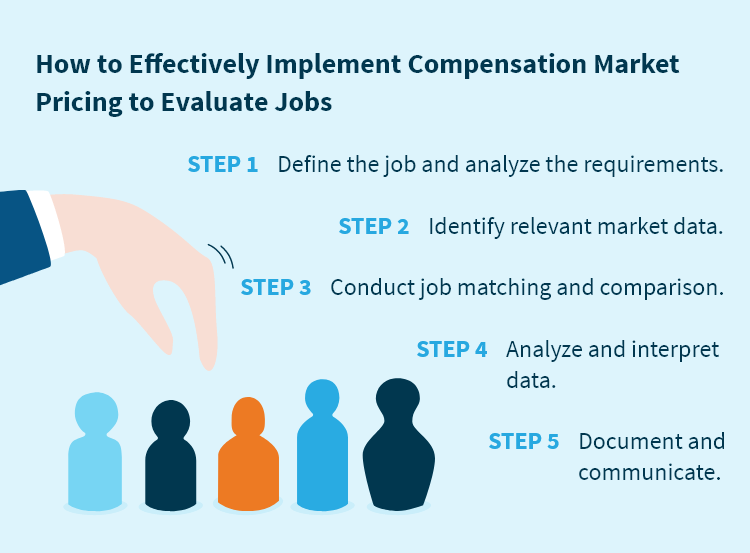How to Effectively Implement Compensation Market Pricing to Evaluate Jobs

- Step 1. Define the job and analyze the requirements.
- Step 2. Identify relevant market data.
- Step 3. Conduct job matching and comparison.
- Step 4. Analyze and interpret data.
- Step 5. Document and communicate.
The process of evaluating jobs is a critical task that every organization must undertake in this competitive job market. A study found that structured job evaluation and compensation lead to higher commitment, lower turnover, better communication, and higher morale among employees. This emphasizes the need for evaluating jobs thoroughly to ensure employees are fairly compensated and that the jobs are aligned with the organization's goals and market trends.
To ensure that job evaluation is accurate and error-free, it's handy to implement compensation market pricing. Before we get into how to implement pay market pricing to evaluate jobs, let's first define it and examine its advantages and challenges.
Why is it important to evaluate jobs?
It's important to evaluate jobs because it helps us understand the value of each role in the organization. This involves assessing job responsibilities, required skills, and effort, which helps determine fair compensation.
As mentioned earlier, having structured job evaluation can lead to employee satisfaction and lower turnover. It also helps identify skill gaps, aiding in recruitment and training. Regular evaluation ensures the organization stays competitive and efficient amid market or industry changes.
The good thing is that you can efficiently evaluate jobs for your organization by using compensation market pricing. But first, what is it, how does it work, and what are its benefits for job evaluation?
What is compensation market pricing?
Compensation market pricing is a method to assess a job's value in the market. It includes analyzing external data, often from salary surveys, to see what similar positions pay at other companies.
The main goal of pay market pricing is to ensure that an organization's salaries are competitive with other companies for similar roles, which helps attract and retain top talent and ensures fairness among employees.
It also helps organizations make informed decisions about salary budgets and adjustments by providing benchmarks based on industry trends, location, and financial resources.
Benefits of compensation market pricing
When companies use accurate compensation market pricing for job evaluations, they can ensure competitive pay, which helps attract and retain top talent. However, there are other benefits of using pay market pricing. They include:
Fairness and consistency. Pay market pricing helps companies pay employees fairly and equally compared to industry standards.
Cost efficiency. It helps companies offer competitive pay without overspending, controlling labor costs while attracting top talent.
Improved talent acquisition. Competitive pay makes a company more appealing to job seekers, bringing in better candidates faster.
Informed compensation decisions. Pay market pricing provides data to make smart choices about pay rates for different roles or skills.
Data-driven talent management. It helps identify areas for training or development to stay competitive.
Regulatory compliance. Pay market pricing ensures pay practices meet legal requirements, reducing legal risks.
Elements of compensation market pricing
Now that you understand some benefits of pay market pricing, let's explore its key components.
Compensation philosophy
This is the foundation of how a company pays its employees. It includes principles like pay-for-performance, fairness inside the company, competitiveness outside, and the overall pay plan.
Benchmark methodology
This is how companies choose and review benchmark jobs, which are important roles found in many industries. These jobs are used to decide on pay levels. The process includes evaluating jobs, comparing pay rates in the market, and matching jobs to external surveys.
Market pricing surveys
These surveys show how much other companies pay for similar jobs. They include details such as base salary, bonuses, and other compensation. Companies use this information to decide on competitive pay rates for each position.
Market positioning
This means comparing a company's pay to market data from surveys. Companies aim to set their pay levels compared to the market, which could mean paying at, above, or below market rates based on their compensation philosophy and talent strategy.
Challenges of implementing compensation market pricing
Implementing pay market pricing is both complex and rewarding. It helps attract top talent and promotes fairness but also poses challenges. These challenges include:
Limited access to reliable benchmarks. It's hard to find accurate salary data, especially for niche jobs. Organizations might need to do their own surveys or use specialized databases.
Data interpretation. Understanding the data correctly is important. This involves aligning job roles with market data, considering location differences, and adjusting for company size and industry.
Balancing competitiveness and affordability. Setting salaries that are competitive yet affordable is tricky. It requires analyzing market trends, competitor practices, and financial limits.
Internal equity considerations. Making sure salaries are fair within the organization is important. This means comparing pay across different roles and departments to find and fix any inequalities.
Defining and communicating the methodology. Having a clear method for deciding salaries is key. It's important to explain this method to employees to build trust.
Managing employee expectations. Employees may expect different salaries based on their own ideas and what they see in the job market. Good communication and feedback can help manage these expectations.
Integration with existing systems. Implementing a new pay strategy might mean fitting it into existing HR and payroll systems. Making sure everything works together smoothly is important.
Keeping up with market changes. Markets and industries change, affecting pay practices. Regularly updating the pay strategy is needed to stay competitive.
Salary.com's Compensation Software helps address these challenges by providing tools for analyzing market data, ensuring internal fairness, integrating the new pay strategy with existing systems, and staying updated with market changes.
How to conduct compensation market pricing to evaluate jobs
As mentioned earlier, pay market pricing is critical for assessing a job's value in the market and establishing equitable compensation. Here's a simple guide to conducting it effectively:
-
Step 1: Define the job and analyze the requirements
Start by clearly defining the job you're evaluating. Understand its role, responsibilities, required skills, qualifications, and experience level. Analyzing these requirements is critical for accurate market data matching later. For instance, when evaluating a software developer position, consider the specific programming languages, tools, and experience levels needed.
-
Step 2: Identify relevant market data
Get market data from trusted sources like industry surveys, compensation databases, and salary reports. This data should cover similar jobs in your industry, region, and organization size. Gather comprehensive data to ensure thorough and current market trend analysis. You may need to subscribe to salary survey services, access industry databases, or use publicly available data from sources like the Bureau of Labor Statistics.
Salary.com's Compensation Software includes a Market Pricing feature that helps you match and price your company jobs quickly and accurately. The tool also includes Minimum Wage Data for tipped and non-tipped employees across all US geographies, keeping you updated with the most recent wages by individual states, cities, counties, and municipalities.
-
Step 3: Conduct job matching and comparison
Match the job you're evaluating to similar jobs in the market based on content, responsibilities, skills, and qualifications. This ensures accurate and relevant compensation analysis. Consider factors like job title, description, and organizational level. For example, when evaluating a marketing manager position, compare it to other marketing manager roles in similar industries and locations.
The software features Job Matching, which can match your job to any compensation survey source you have or to the tool's Market Data. It helps you find the right survey cuts for your composites with AI-recommended job matches and automated scopes.
-
Step 4: Analyze and interpret data
After collecting market data and matching the job, analyze it to find the market rate. Look at factors like median, average, and salary range for similar positions. Consider additional benefits or perks associated with these roles. This analysis shows where the job fits in the market, helping you decide on compensation levels. Also, consider the broader economic context, industry trends, and any unique factors affecting compensation in your industry or region.
With Reporting feature, you can make better pay choices and hire more confidently. It merges your company's internal job and employee data with external market data for strong compensation analysis.
-
Step 5: Document and communicate
Document your findings and the reasons for your compensation decisions. Include sources of market data, job matching methodology, and the rationale behind your final recommendation. Communicate the results to relevant stakeholders to ensure transparency and understanding. Effective communication is key to ensuring fairness, addressing questions, and building trust within the organization.
This tool provides access to a comprehensive database of 100% HR-reported market data from 15,000 job titles, 225 industries, and 42,000 geographies, which is analyzed and updated monthly by Certified Compensation Professionals.
Having accurate market pricing information is important for evaluating jobs correctly. Salary.com's Compensation Software provides up-to-date market rates, which allows organizations to streamline their compensation market pricing process. It also offers insights into compensation trends, helping organizations remain competitive in this job market.
Insights You Need to Get It Right









